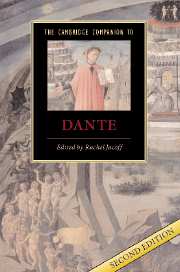Book contents
- Frontmatter
- 1 Life of Dante
- 2 Dante and the lyric past
- 3 Approaching the Vita nuova
- 4 From auctor to author: Dante before the Commedia
- 5 Introduction to Inferno
- 6 Introduction to Purgatorio
- 7 Introduction to Paradiso
- 8 Dante and the Bible
- 9 Dante and the classical poets
- 10 Allegory and autobiography
- 11 A poetics of chaos and harmony
- 12 The theology of the Comedy
- 13 The poetry and poetics of the creation
- 14 Dante and Florence
- 15 Dante and the empire
- 16 Dante and his commentators
- 17 Dante in English
- Further reading
- Index
- Series List
8 - Dante and the Bible
Published online by Cambridge University Press: 28 May 2007
- Frontmatter
- 1 Life of Dante
- 2 Dante and the lyric past
- 3 Approaching the Vita nuova
- 4 From auctor to author: Dante before the Commedia
- 5 Introduction to Inferno
- 6 Introduction to Purgatorio
- 7 Introduction to Paradiso
- 8 Dante and the Bible
- 9 Dante and the classical poets
- 10 Allegory and autobiography
- 11 A poetics of chaos and harmony
- 12 The theology of the Comedy
- 13 The poetry and poetics of the creation
- 14 Dante and Florence
- 15 Dante and the empire
- 16 Dante and his commentators
- 17 Dante in English
- Further reading
- Index
- Series List
Summary
Underwriting the entire world in which Dante lived is a single book, the Bible. Believed to be authored by a God who chose human scribes to speak his word, it had an authority quite beyond any other text. For this reason it was the most studied book in the Middle Ages, both the primer on which the young clerk learned his alphabet, and the “sacred page” that dominated every branch of higher learning. Not that the power of the Scriptures was limited to school or to the literate. As the holy book of the church, it not only informed liturgy and preaching, art and architecture, but also constituted a vast and complex symbolic network that was intelligible, on whatever level, to all classes of society. Far more than Latin, the Bible itself was the universal “language” of Christian culture.
It is not surprising, then, that when Dante's writings are considered as a whole, the Christian Scriptures should be the source of more reference and allusion than any other work: by one count there are 575 citations of the Bible in Dante, compared with 395 to Aristotle and 192 to Virgil. Calculations of this sort, however, do not suggest the degree to which Dante absorbed the world of the Bible. This is most notably true in the Commedia, where the Old and New Testaments, both in Latin and in vernacular translation, so permeate his language as almost to become one with it. Sometimes the poet will quote the Bible or openly draw attention to its relevance; far more often, however, he will allow its presence to go unannounced, relying on the reader to catch the biblical resonance and make something of it.
- Type
- Chapter
- Information
- The Cambridge Companion to Dante , pp. 125 - 140Publisher: Cambridge University PressPrint publication year: 2007
- 2
- Cited by

